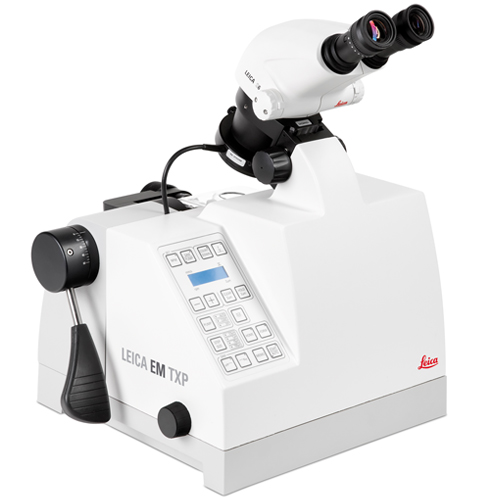Combination of Leica EM TXP and Leica DM2700 M helps increase efficiency and improve workflow

Uniting four machine technologies in one instrument, the Leica EM TXP allows to complete all required machining steps.
Photo by Leica Microsystems GmbH
A new approach to create an efficient, fast and precise workflow in Quality Control Quality control of multilayer coatings on metal and plastic samples, like it is daily routine in automotive or microelectronic industry, requires a rather time consuming workflow with a lot of different steps and machines. A new approach combining the target surfacing system Leica EM TXP and the light microscope Leica DM2700 M allows to reduce the required procedure, streamline the workflow and produce reliable and precise results.
Conventional Sample Preparation: Time-consuming and difficult
When coatings of copper, nickel or chrome on metal and plastic components are prepared for incident light microscopy in industrial quality control, the specimen usually undergoes multiple processes until the layer or surface to be analyzed is machined with precision. Usually, a cross section of the sample is cut, embedded into resin to be handled and then polished various times to afterwards inspect every single layer for its thickness. This process takes about four hours to be finished. Alternatively, a cross section of the sample is cut directly in the area of the defect and then polished various times. This highly complicated process takes whole day to be completed. A quality control laboratory working with conventional methods needs a workbench fully equipped with various systems for milling, sawing, trimming, grinding, and polishing. Due to the time consuming and complicated procedures, one technician will be fully occupied with one or two samples a day, which leads to a low throughput.
Uniting four machine technologies in one instrument
Uniting four machine technologies in one instrument, the Leica EM TXP allows to complete all required machining steps from cutting to milling and polishing in one system without pre-embedding the sample into resin. This offers various important benefits for the workflow and the quality of results.
Keeping the sample in place saves time
Once the sample is clamped into the specimen holder and inserted in the pivot arm, the specimen can be milled, sawn, drilled, trimmed, ground, and polished without removing the sample from the Leica EM TXP. All processing steps are carried out consecutively on the Leica EM TXP. Without the need to remove the sample to other machines the user saves precious time and avoids the risk of losing specimen details.
Observation during working process eliminates errors
With the specimen pivot arm the sample can be observed during preparation at an angle between 0° and 60°, directly onto the front face, or 90° to the front face for distance determination with an eyepiece graticule. Being able to constantly observe the sample live during the process eliminates the risk of missing the target or over-polish the surface, especially when working in the center of a defect. Moreover, observing the sample during operation avoids the time consuming interruption of locating the target with a standalone microscope and then re-aligning the sample in the polishing instrument.
No need for embedding
Conventional sample preparation of multilayer surface often implies embedding the sample – which is time consuming and costly. With the Leica EM TXP there is no need for embedding: The sample holder features many different sizes and thus allows to securely and easily process and observe the sample, no matter its size and form. Due to the perfect perpendicular alignment with the preparation tools and holders, the prepared surface always stays at the right angle for preparation. After preparation, the sample can be taken on the same holder to a light microscope for further investigation without the need of re-mounting it.
Automation boosts efficiency
Thanks to the Leica EM TXP’s automation all parameters can be preset for each operating step; the instrument then works fully automatically. In this way, several samples of one manufactured batch can be prepared per day and increase the product’s quality. The addition of a microscope camera allows the staff to document the results and discuss the results by watching them on a monitor.
Reliable sample inspection with light microscope
Combining the target surfacing system with a flexible upright material microscope offers further benefits for the workflow. The Leica DM2700 M is a flexibly configurable material microscope meeting the individual customer needs. It uses LED illumination for all contrast methods: brightfield (BF), darkfield (DF), differential interference contrast (DIC), qualitative polarization (POL), and fluorescence (FLUO) applications. It also offers a built-in oblique illumination, which improves the visualization of surface topography and defects. For reliable and reproducible results the microscope features a color coded diaphragm assistant (CCD) which secures always optimized illumination conditions. The CCD makes operation easy and intuitive for any operator, avoids operating errors and can thus speed up the workflow dramatically. The combination of the surface target system Leica EM TXP and the material microscope Leica DM2700 M allows to have a state- of the art yet easy to handle QC laboratory at hand. It can help to speed up the workflow, increase throughput, avoid errors and thus optimize quality.
For more information, please visit http://www.leica-microsystems.com.
News Categories
- » NEWS HOME
- » Automation & Robotics
- » Industry 4.0
- » Material Handling
- » Sensors
- » Quality & Testing
- » Machine Vision
- » Laser & Optics
- » Metalworking
- » Motion Control & Drives
- » Hydraulics & Pneumatics
- » Process Industry
- » Renewable Energy
- » Agriculture
- » Home & Office Furniture
- » Environmental Tech

